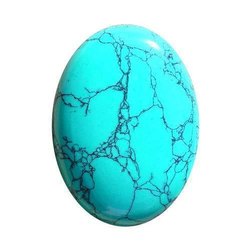Turquoise

Turquoise is an opaque, blue-to-green mineral. It is rare and valuable in finer grades and has been prized as a gemstone and ornamental stone for thousands of years owing to its unique hue. Like most other opaque gems, turquoise has been devalued by the introduction onto the market of treatments, imitations and synthetics.
The gemstone has been known by many names. Pliny the Elder referred to the mineral as callais (from Ancient Greek κάλαϊς) and the Aztecs knew it as chalchihuitl. The word turquoise dates to the 17th century and is derived from the French turquoise meaning “Turkish” because the mineral was first brought to Europe through Turkey, from mines in the historical Khorasan of Persia.
Turquoise was among the first gems to be mined, and many historic sites have been depleted, though some are still worked to this day. Iran has been an important source of turquoise for at least 2,000 years. Since at least the First Dynasty (3000 BCE) in ancient Egypt, and possibly before then, turquoise was used by the Egyptians and was mined by them in the Sinai Peninsula. This region was known as the Country of Turquoise by the native Monitu. The two most important of these mines, from a historic perspective, are Serabit el-Khadim and Wadi Maghareh, believed to be among the oldest of known mines.
Spiritual Properties of turquoise:
- It offers calm and relaxation, banishes depression and promotes the feeling of love and friendship. It boosts self-confidence, gives courage, strength and positive energy to the speakers.
- Increases creative thinking, perception, dispels confusion, makes us extroverted and helps us in every new beginning
Healing properties of turquoise:
- Improves the absorption of nutrients and is used to treat diseases of the nose, throat and lungs.
- Strengthens the heart and vision, relieves headaches, fights viruses.
Turquoise is the birthstone of December.


